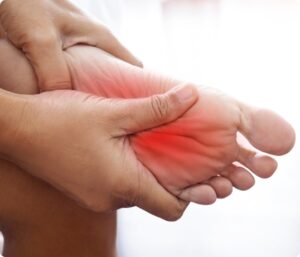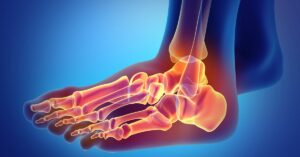Diabetic arthropathy, a less commonly discussed complication of diabetes, manifests as joint pain, stiffness, and swelling due to the long-term effects of high blood sugar levels on joint health. As diabetes continues to affect millions worldwide, understanding and managing its complications, including arthropathy, is crucial for maintaining quality of life. This comprehensive guide aims to shed light on the multifaceted approach to diabetic arthropathy treatment, blending lifestyle adjustments, medical interventions, and supportive therapies to alleviate symptoms and slow disease progression.
Contents
When To Seek Diabetic Arthropathy Treatment?
 Seeking diabetic arthropathy treatment should be considered as soon as the first signs and symptoms appear or if you have diabetes and start noticing joint pain, stiffness, or swelling. Here are specific situations and symptoms to look for:
Seeking diabetic arthropathy treatment should be considered as soon as the first signs and symptoms appear or if you have diabetes and start noticing joint pain, stiffness, or swelling. Here are specific situations and symptoms to look for:
- Persistent Joint Pain or Swelling: If you experience joint pain or swelling that doesn’t improve with rest or over-the-counter pain relievers, especially in the feet, ankles, and hands, it’s time to consult a healthcare provider.
- Stiffness in the Morning: Difficulty moving joints when you wake up. This might improve with activity, which can be a sign of arthropathy.
- Limited Range of Motion: Noticeable reduction in the ability to move joints through their full range of motion. And, making daily activities challenging.
- Signs of Nerve Damage: Symptoms such as tingling, numbness, or burning sensations, particularly in the hands or feet, can indicate diabetic neuropathy. It often accompanies arthropathy.
- Changes in Joint Appearance: Deformities or changes in the shape of your joints, or the development of hard lumps around the joints, can signal the need for professional evaluation.
- No Improvement with Initial Treatment: If you’ve already been diagnosed with diabetic arthropathy and your current management plan isn’t relieving your symptoms, discuss other treatment options with your healthcare provider.
- Symptoms Affect Emotional Well-being: Chronic pain and mobility issues can lead to depression and anxiety. If your emotional well-being is affected, seek help.
It’s important to manage your diabetes effectively to prevent complications, including diabetic arthropathy. Regular check-ups with your healthcare provider can help monitor your condition and adjust your treatment plan as necessary.
What Are The Medical Diabetic Arthropathy Treatments?
 Medical treatments for diabetic arthropathy focus on managing symptoms, slowing disease progression, and maintaining joint function. Here’s an overview of the medical treatments commonly used for diabetic arthropathy:
Medical treatments for diabetic arthropathy focus on managing symptoms, slowing disease progression, and maintaining joint function. Here’s an overview of the medical treatments commonly used for diabetic arthropathy:
Pain Management with NSAIDs and Acetaminophen
Nonsteroidal Anti-Inflammatory Drugs (NSAIDs) are a cornerstone for managing pain and inflammation associated with diabetic arthropathy. Medications like ibuprofen and naproxen reduce inflammation and relieve pain, making daily activities more manageable. However, they must be used with caution. Acetaminophen, while not anti-inflammatory, can be an alternative for pain relief in patients who cannot tolerate NSAIDs.
Corticosteroids
Corticosteroid injections provide a powerful anti-inflammatory effect directly to the affected joint. They can offer significant relief from pain and swelling, particularly in joints severely affected by arthropathy. However, the relief is usually temporary, and repeated injections can lead to joint damage and other side effects, such as increased blood sugar levels. And, making careful monitoring essential, especially in diabetic patients.
Antidepressants and Anticonvulsants
Antidepressants, like duloxetine, and anticonvulsants, such as gabapentin, are used to manage chronic pain, including neuropathic pain associated with diabetes. These medications alter the way the brain processes pain signals, providing relief. While effective, they require time to adjust the right dosage for each patient and can have side effects that need monitoring.
Topical Treatments
Topical treatments offer localized pain relief with minimal systemic absorption, making them a safer option for many. Capsaicin cream, derived from chili peppers, works by depleting substance P, a chemical involved in conveying pain sensations to the brain. Lidocaine patches numb the skin, providing temporary relief from pain without the systemic side effects associated with oral medications.
DMARDs and Biologics
Disease-modifying antirheumatic Drugs (DMARDs) and biologic agents are primarily used in rheumatic diseases but may have a role in severe diabetic arthropathy with significant inflammatory components. By targeting specific pathways involved in inflammation, these drugs can slow disease progression. However, their use in diabetic arthropathy is off-label and based on the discretion of a specialist, considering the potential for serious side effects.
Physical and Occupational Therapy
Therapy is essential for maintaining joint function, flexibility, and strength. Physical therapists can design exercise programs tailored to the individual’s needs, focusing on gentle stretching and strengthening exercises to support joint health. Occupational therapists can recommend adaptive devices to help with daily tasks, reducing strain on affected joints.
Surgical Options
Surgery, such as joint replacement, is considered for individuals with severe joint damage who have not responded to other treatments. While surgery can significantly improve quality of life by restoring function and reducing pain, it carries risks and requires a considerable recovery period. Decisions about surgery are made on a case-by-case basis, considering the overall health and specific needs of the patient.
Tight Glucose Control
Effectively managing blood sugar levels is critical in slowing the progression of diabetic complications, including arthropathy. Tight glucose control involves regular monitoring of blood sugar levels, appropriate use of insulin or other diabetes medications, and lifestyle adjustments. Maintaining blood sugar levels within target ranges can prevent or delay the onset of diabetic arthropathy and other complications, underscoring the importance of a comprehensive diabetes management plan.
Together, these treatment strategies provide a multifaceted approach to managing diabetic arthropathy, tailored to the severity of the condition and the individual’s specific health needs. Collaboration between healthcare providers and patients is crucial to optimizing treatment outcomes and enhancing quality of life.
How Is Diabetic Arthropathy Treated Naturally?
 Treating diabetic arthropathy naturally involves a combination of lifestyle modifications, dietary adjustments, and the use of certain supplements that may help manage symptoms and improve joint health. Here are some natural strategies for managing diabetic arthropathy:
Treating diabetic arthropathy naturally involves a combination of lifestyle modifications, dietary adjustments, and the use of certain supplements that may help manage symptoms and improve joint health. Here are some natural strategies for managing diabetic arthropathy:
Exercise and Physical Activity
Regular, gentle exercise can help maintain joint mobility, reduce pain, and improve strength. Activities such as swimming, cycling, and walking are low-impact and can be beneficial. Yoga and tai chi can also improve flexibility, balance, and stress reduction, positively affecting overall well-being.
Weight Management
Maintaining a healthy weight reduces stress on the joints, especially weight-bearing joints like the knees and hips, potentially alleviating symptoms of arthropathy. Weight loss can also improve blood sugar control. This is crucial in managing diabetes and its complications.
Healthy Diet
A diet rich in fruits, vegetables, whole grains, lean proteins, and healthy fats can help manage diabetes and reduce inflammation. Some specific dietary recommendations include:
- Anti-inflammatory Foods: Foods high in omega-3 fatty acids (such as salmon, flaxseeds, and walnuts) and antioxidants (found in berries, leafy greens, and nuts) may help reduce joint inflammation.
- Low-Glycemic Index Foods: Choosing foods that have a minimal impact on blood sugar levels can help maintain stable blood glucose, important for managing diabetes and its complications.
Supplements
Certain dietary supplements may support joint health and reduce inflammation. Though they should be used under the guidance of a healthcare provider:
- Omega-3 Fatty Acids: Can reduce inflammation and have been shown to benefit joint health.
- Curcumin: The active component in turmeric, curcumin, has strong anti-inflammatory properties and has been shown to alleviate joint pain and stiffness in some studies.
- Magnesium: Important for bone health and muscle function, magnesium supplements may help with diabetic arthropathy symptoms.
- Vitamin D: Essential for calcium absorption and bone health, adequate vitamin D levels are important for preventing and managing joint pain.
Heat and Cold Therapy
Applying heat can relax muscles and alleviate stiffness in the joints, while cold therapy can reduce inflammation and numb pain. Using a heating pad, warm bath, or cold pack can provide temporary relief from arthropathy symptoms.
Acupuncture and Massage
Acupuncture may help relieve chronic pain by stimulating nerves and affecting the pain pathways. Massage therapy can reduce muscle tension and improve circulation. And, offering relief from pain and stiffness associated with diabetic arthropathy.
Stress Management
Chronic stress can exacerbate pain and inflammation. Techniques such as deep breathing exercises, meditation, and mindfulness can help manage stress levels. And, potentially reducing the impact of symptoms.
While these natural approaches can support overall well-being and potentially alleviate some symptoms of diabetic arthropathy, they are not substitutes for conventional medical treatment. Hence, it’s crucial to work closely with healthcare professionals to create a comprehensive treatment plan.
Conclusion
In conclusion, diabetic arthropathy treatment requires a multifaceted approach that combines medical interventions with natural strategies to alleviate symptoms, improve joint health, and maintain quality of life. From medications and physical therapy to diet modifications, exercise, and natural supplements, each element plays a crucial role in a comprehensive treatment plan.
While living with diabetic arthropathy can be challenging, early diagnosis, effective management of diabetes, and a proactive approach to treatment can significantly reduce the impact of this condition. Do you want to get rid of diabetes? Join our online diabetes treatment program and reverse Diabetes naturally through lifestyle changes such as a Personalized Diet plan, Exercise, Yoga, dieticians, and health coaches.

